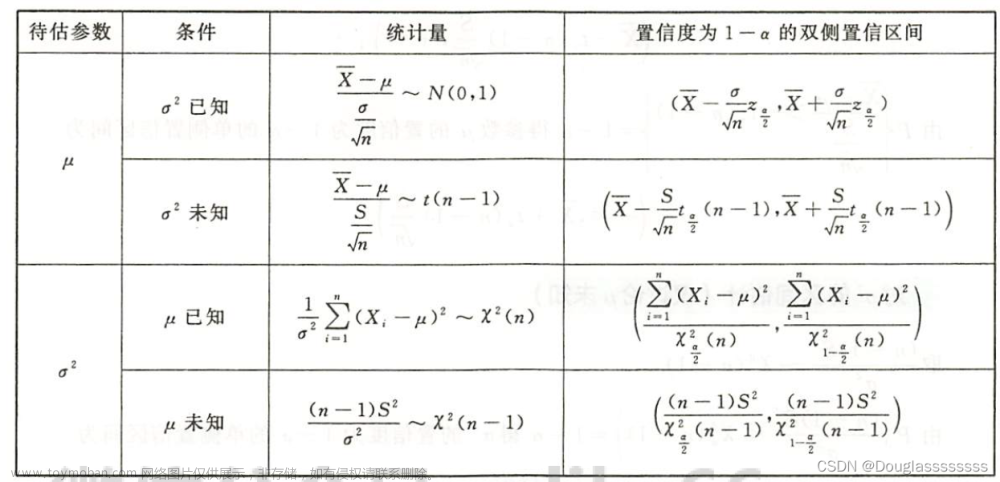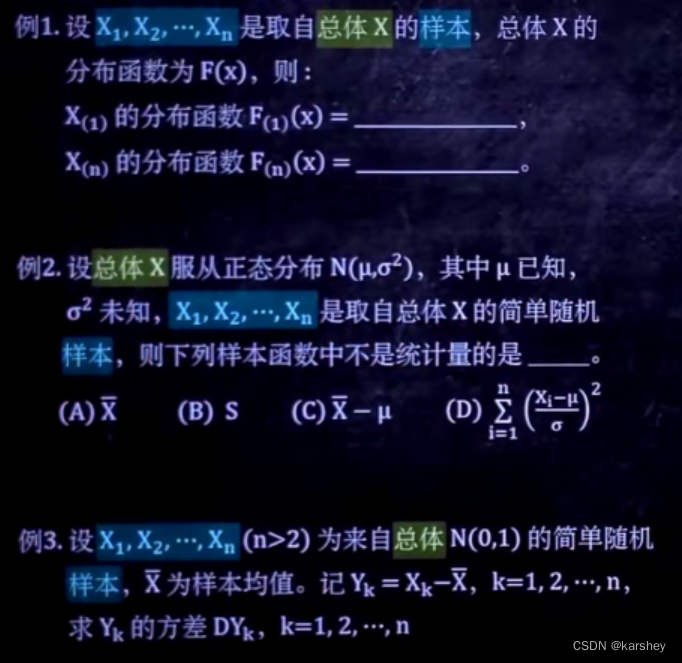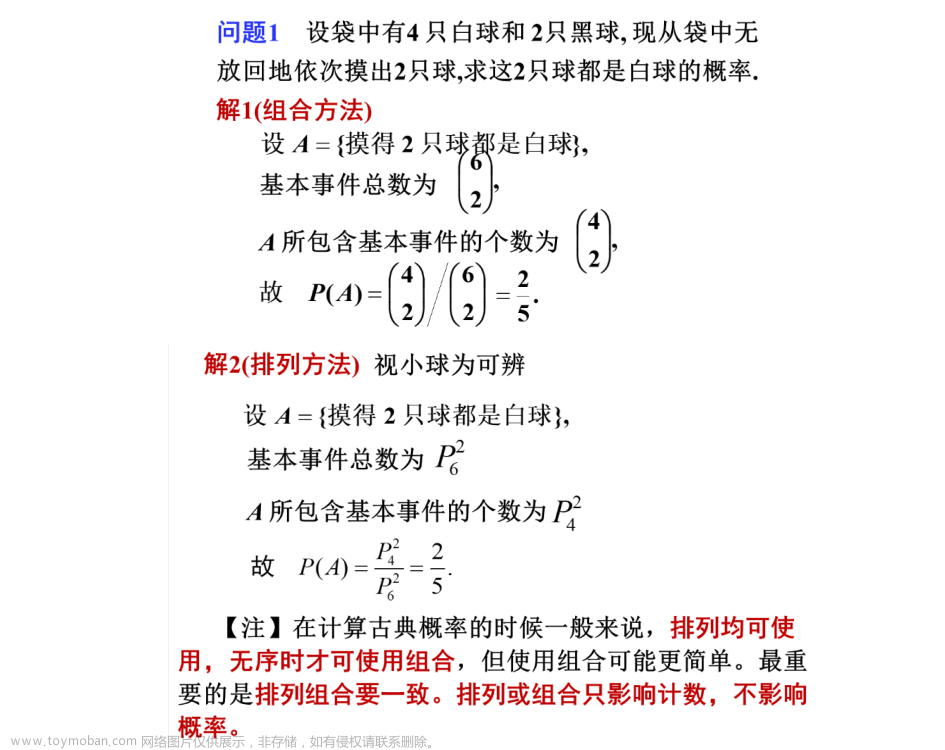概率论习题之标准正态绝对值的期望
一、主要注意的点
E ∣ X ∣ = 2 Π 计算 : E ∣ X ∣ = ∫ − ∞ + ∞ ∣ X ∣ f ( x ) d x E Z = E ∣ x − μ ∣ E|X|={\sqrt{\frac{2}{\Pi}} }\\ 计算:E|X|=\displaystyle \int^{+\infty}_{-\infty}{|X|f(x)dx}\\ EZ=E|x-\mu| E∣X∣=Π2计算:E∣X∣=∫−∞+∞∣X∣f(x)dxEZ=E∣x−μ∣
二、习题
X ∼ N ( 0 , 1 ) , E ( ∣ X ∣ ) = 2 Π X\sim N(0,1),E(|X|)=\sqrt{\frac{2}{\Pi}} X∼N(0,1),E(∣X∣)=Π2
X
∼
N
(
3
,
9
)
,
E
(
∣
X
−
3
∣
)
=
X\sim N(3,9),E(|X-3|)=
X∼N(3,9),E(∣X−3∣)=
处理一般正态的基本操作:1.标准化 2.标准正态
E
∣
X
−
3
3
∣
=
2
π
等式左右两边同时乘以
3
E
∣
X
−
3
∣
=
3
2
π
E|\frac{X-3}{3}|=\sqrt{\frac{2}{\pi}}\\ 等式左右两边同时乘以3\\ E|X-3|=\frac{3\sqrt 2}{\sqrt{\pi}}\
E∣3X−3∣=π2等式左右两边同时乘以3E∣X−3∣=π32
X
∼
N
(
μ
,
σ
2
)
,
Z
=
∣
X
−
μ
∣
,
E
(
Z
)
=
X\sim N(\mu,\sigma^2),Z=|X-\mu|,E(Z)=
X∼N(μ,σ2),Z=∣X−μ∣,E(Z)=
标准化
:
E
∣
X
−
μ
σ
∣
=
2
π
默认
σ
大于
0
,即在等式两边同时乘以
σ
E
∣
X
−
μ
∣
=
2
μ
π
标准化:E|\frac{X-\mu}{\sigma}|=\frac{2}{\pi}\\ 默认\sigma大于0,即在等式两边同时乘以\sigma\\ E|X-\mu|=\frac{\sqrt{2}\mu}{\sqrt{\pi}}\\
标准化:E∣σX−μ∣=π2默认σ大于0,即在等式两边同时乘以σE∣X−μ∣=π2μ
设(
x
,
y
)
∼
N
(
0
,
0
;
1
2
,
1
2
;
0
)
,
ϕ
(
x
)
为标准正态函数,则
P
{
X
−
Y
<
E
∣
X
−
Y
∣
}
=
S
E
T
(
x
,
y
)
∼
N
(
0
,
0
;
1
2
,
1
2
;
0
)
,
ϕ
(
x
)
i
s
a
s
t
a
n
d
a
r
d
n
o
r
m
a
l
f
u
n
c
t
i
o
n
,
t
h
e
n
P
{
X
−
Y
<
E
∣
X
−
Y
∣
}
=
设(x,y)\sim N(0,0;\frac{1}{2},\frac{1}{2};0),\phi(x)为标准正态函数,则P \lbrace X-Y<E|X-Y|\rbrace=\\ SET ~(x,y)\sim N(0,0; \frac{1}{2},\frac{1}{2}; 0), \phi(x) ~is ~a ~standard~ normal ~function, ~then ~P \lbrace X-Y<E|X-Y|\rbrace=
设(x,y)∼N(0,0;21,21;0),ϕ(x)为标准正态函数,则P{X−Y<E∣X−Y∣}=SET (x,y)∼N(0,0;21,21;0),ϕ(x) is a standard normal function, then P{X−Y<E∣X−Y∣}=
X
∼
N
(
0
,
1
2
)
Y
∼
N
(
0
,
1
2
)
(
正态分布的线性组合服从一维正态
)
L
i
n
e
a
r
c
o
m
b
i
n
a
t
i
o
n
s
o
f
n
o
r
m
a
l
d
i
s
t
r
i
b
u
t
i
o
n
s
o
b
e
y
o
n
e
−
d
i
m
e
n
s
i
o
n
a
l
n
o
r
m
a
l
X
−
Y
∼
N
(
0
,
1
)
(
期望相减,方差相加
)
E
x
p
e
c
t
a
t
i
o
n
s
a
r
e
s
u
b
t
r
a
c
t
e
d
,
a
n
d
v
a
r
i
a
n
c
e
s
a
r
e
a
d
d
e
d
E
(
X
−
Y
)
=
2
π
p
l
e
a
s
e
l
e
t
Z
=
x
−
y
S
o
P
Z
<
E
∣
X
−
Y
∣
=
Φ
(
2
π
)
X\sim N(0,\frac{1}{2})\\ Y\sim N(0,\frac{1}{2})\\ (正态分布的线性组合服从一维正态)\\ Linear~combinations~\\ of ~normal~ distributions ~obey~ one-dimensional~normal\\ X-Y\sim N(0,1) ~~(期望相减,方差相加)\\ Expectations ~are ~subtracted, and ~variances~ are~added\\ E(X-Y)=\frac{\sqrt{2}}{\sqrt{\pi}}\\ please~let~~Z=x-y\\ So~~P{Z<E|X-Y|}=\Phi(\sqrt{\frac{2}{\pi}})\\
X∼N(0,21)Y∼N(0,21)(正态分布的线性组合服从一维正态)Linear combinations of normal distributions obey one−dimensional normalX−Y∼N(0,1) (期望相减,方差相加)Expectations are subtracted,and variances are addedE(X−Y)=π2please let Z=x−ySo PZ<E∣X−Y∣=Φ(π2)
设
X
1
,
X
2
为来自总体
N
(
μ
,
σ
2
)
的简单随机样本,记
σ
^
=
a
∣
X
1
−
X
2
∣
,
若
E
(
σ
)
=
σ
,
则
a
=
L
e
t
X
1
a
n
d
X
2
b
e
s
i
m
p
l
e
r
a
n
d
o
m
s
a
m
p
l
e
s
f
r
o
m
t
h
e
p
o
p
u
l
a
t
i
o
n
N
(
μ
,
σ
2
)
a
n
d
d
e
n
o
t
e
σ
^
=
a
∣
X
1
−
X
2
∣
,
i
f
E
(
σ
)
=
σ
,
t
h
e
n
a
=
设X1,X2为来自总体N(\mu,\sigma^2)的简单随机样本,记\hat{\sigma}=a|X1-X2|,若E(\sigma)=\sigma,则a=\\ Let ~X1 ~and~ X2 ~be ~simple ~random ~samples~ from ~the~ population ~N(\mu,\sigma^2) ~and ~denote ~\hat{\sigma}=a|X1-X2|, \\ if ~E(\sigma)=\sigma, then ~a=
设X1,X2为来自总体N(μ,σ2)的简单随机样本,记σ^=a∣X1−X2∣,若E(σ)=σ,则a=Let X1 and X2 be simple random samples from the population N(μ,σ2) and denote σ^=a∣X1−X2∣,if E(σ)=σ,then a=
X
1
∼
N
(
μ
,
σ
2
)
X
2
∼
N
(
μ
,
σ
2
)
E
(
σ
^
)
=
E
(
a
∣
X
1
−
X
2
∣
)
=
a
E
∣
X
1
−
X
2
∣
X
1
−
X
2
∼
N
(
0
,
2
σ
2
)
X
1
−
X
2
2
μ
∼
N
(
0
,
1
)
E
∣
X
1
−
X
2
2
μ
=
2
π
B
o
t
h
s
i
d
e
s
o
f
t
h
e
e
q
u
a
t
i
o
n
a
r
e
m
u
l
t
i
p
l
i
e
d
b
y
2
μ
a
t
t
h
e
s
a
m
e
t
i
m
e
E
∣
X
1
−
X
2
∣
=
2
σ
π
S
o
E
(
σ
^
)
=
a
⋅
2
σ
π
=
σ
2
π
⋅
a
=
1
a
=
π
2
X1\sim N(\mu,\sigma^2)\\ X2\sim N(\mu,\sigma^2)\\ E(\hat{\sigma})=E(a|X1-X2|)=aE|X1-X2|\\ X1-X2\sim N(0,2\sigma^2)\\ \frac{X1-X2}{\sqrt{2}\mu} \sim N(0,1)\\ E|\frac{X1-X2}{\sqrt{2}\mu}=\sqrt{\frac{2}{\pi}}\\ Both~sides~of~the~equation~are~multiplied~by~ \sqrt{2}\mu~at~the~same~time\\ E|X1-X2|=\frac{2\sigma}{\sqrt{\pi}}\\ So~~E(\hat{\sigma})=a \cdot \frac{2\sigma}{\sqrt{\pi}}=\sigma\\ \frac{2}{\sqrt{\pi}} \cdot a=1\\ a = \frac{\sqrt{\pi}}{2}\\
X1∼N(μ,σ2)X2∼N(μ,σ2)E(σ^)=E(a∣X1−X2∣)=aE∣X1−X2∣X1−X2∼N(0,2σ2)2μX1−X2∼N(0,1)E∣2μX1−X2=π2Both sides of the equation are multiplied by 2μ at the same timeE∣X1−X2∣=π2σSo E(σ^)=a⋅π2σ=σπ2⋅a=1a=2π
设二维随机变量
(
X
1
,
X
2
)
∼
N
(
0
,
0
;
1
,
1
;
0
)
,
记
X
=
max
{
X
1
,
X
2
}
,
Y
=
min
{
X
1
,
X
2
}
,
Z
=
X
−
Y
,
求
E
(
Z
)
L
e
t
t
h
e
t
w
o
−
d
i
m
e
n
s
i
o
n
a
l
r
a
n
d
o
m
v
a
r
i
a
b
l
e
(
X
1
,
X
2
)
∼
N
(
0
,
0
;
1
,
1
;
0
)
,
w
r
i
t
e
X
=
m
a
x
{
X
1
,
X
2
}
,
Y
=
m
i
n
{
X
1
,
X
2
}
,
Z
=
X
−
Y
,
a
n
d
f
i
n
d
E
(
Z
)
设二维随机变量(X1,X2)\sim N(0,0;1,1;0),记X=\max\lbrace X1,X2 \rbrace,Y=\min\lbrace X1,X2 \rbrace,Z=X-Y,求E(Z)\\ Let ~the~ two-dimensional ~random ~variable(X1,X2)\sim N(0,0; 1,1; 0),\\ ~ write ~X=max\lbrace X1,X2 \rbrace,Y=min\lbrace X1,X2 \rbrace,Z=X-Y, and ~find E(Z)
设二维随机变量(X1,X2)∼N(0,0;1,1;0),记X=max{X1,X2},Y=min{X1,X2},Z=X−Y,求E(Z)Let the two−dimensional random variable(X1,X2)∼N(0,0;1,1;0), write X=max{X1,X2},Y=min{X1,X2},Z=X−Y,and findE(Z)
X
1
∼
N
(
0
,
1
)
X
2
∼
N
(
0
,
1
)
E
(
Z
)
=
E
(
X
−
Y
)
i
f
X
1
>
X
2
,
Z
=
X
−
Y
=
X
1
−
X
2
e
l
s
e
Z
=
X
−
Y
=
X
2
−
X
1
S
o
Z
=
∣
X
1
−
X
2
∣
E
(
Z
)
=
E
(
∣
X
−
Y
∣
)
s
t
a
n
d
a
r
d
i
z
a
t
i
o
n
:
X
1
−
X
2
2
∼
N
(
0
,
1
)
E
∣
X
1
−
X
2
2
∣
=
2
π
B
o
t
h
s
i
d
e
s
o
f
t
h
e
e
q
u
a
t
i
o
n
a
r
e
m
u
l
t
i
p
l
i
e
d
b
y
2
a
t
t
h
e
s
a
m
e
t
i
m
e
E
(
X
1
−
X
2
)
=
2
π
X1\sim N(0,1)\\ X2\sim N(0,1)\\ E(Z)=E(X-Y)\\ if~~X1>X2,Z=X-Y=X1-X2\\ else~~Z=X-Y=X2-X1\\ So~~Z=|X1-X2|\\ E(Z)=E(|X-Y|)\\ standardization~:\frac{X1-X2}{\sqrt{2}}\sim N(0,1)\\ E|\frac{X1-X2}{\sqrt{2}}|=\sqrt{\frac{2}{\pi}}\\ Both~sides~of~the~equation~are~multiplied~by~ \sqrt{2}~at~the~same~time\\ E(X1-X2)=\frac{2}{\sqrt{\pi}}\\
X1∼N(0,1)X2∼N(0,1)E(Z)=E(X−Y)if X1>X2,Z=X−Y=X1−X2else Z=X−Y=X2−X1So Z=∣X1−X2∣E(Z)=E(∣X−Y∣)standardization :2X1−X2∼N(0,1)E∣2X1−X2∣=π2Both sides of the equation are multiplied by 2 at the same timeE(X1−X2)=π2文章来源:https://www.toymoban.com/news/detail-839890.html
设
X
1
与
X
2
相互独立,且服从正态分布
N
(
μ
,
σ
2
)
,
求
E
{
(
X
1
,
X
2
}
)
L
e
t
X
1
a
n
d
X
2
b
e
i
n
d
e
p
e
n
d
e
n
t
o
f
e
a
c
h
o
t
h
e
r
a
n
d
o
b
e
y
t
h
e
n
o
r
m
a
l
d
i
s
t
r
i
b
u
t
i
o
n
N
(
μ
,
σ
2
)
,
a
n
d
f
i
n
d
E
{
(
X
1
,
X
2
}
)
设X1与X2相互独立,且服从正态分布N(\mu,\sigma^2),求E\lbrace (X1,X2\rbrace)\\ Let ~X1 ~and~ X2 ~be ~independent ~of ~each ~other ~and ~obey~ the ~normal ~distribution N(\mu,\sigma^2), and ~find ~E\lbrace(X1,X2\rbrace)
设X1与X2相互独立,且服从正态分布N(μ,σ2),求E{(X1,X2})Let X1 and X2 be independent of each other and obey the normal distributionN(μ,σ2),and find E{(X1,X2})
X
1
∼
N
(
μ
,
σ
2
)
X
2
∼
N
(
μ
,
σ
2
)
E
{
max
(
x
1
,
x
2
)
=
1
2
(
x
1
+
x
2
+
∣
x
1
−
x
2
∣
)
)
}
=
1
2
(
E
(
X
1
)
+
E
(
X
2
)
+
E
∣
X
1
−
X
2
∣
)
X
1
−
X
2
∼
N
(
0
,
2
σ
2
)
X
1
−
X
2
2
σ
∼
N
(
0
,
1
)
E
∣
X
1
−
X
2
2
σ
∣
=
2
π
E
(
X
1
−
X
2
)
=
2
σ
π
E
{
max
(
x
1
,
x
2
)
=
1
2
(
x
1
+
x
2
+
∣
x
1
−
x
2
∣
)
)
}
=
1
2
(
E
(
X
1
)
+
E
(
X
2
)
+
E
∣
X
1
−
X
2
∣
)
=
1
2
(
μ
+
μ
+
2
σ
π
)
=
μ
+
σ
π
X1\sim N(\mu,\sigma^2)\\ X2\sim N(\mu,\sigma^2)\\ E\lbrace\max(x1,x2)=\frac{1}{2}(x1+x2+|x1-x2|))\rbrace\\ =\frac{1}{2}(E(X1)+E(X2)+E|X1-X2|)\\ X1-X2\sim N(0,2\sigma^2)\\ \frac{X1-X2}{\sqrt{2}\sigma}\sim N(0,1)\\ E|\frac{X1-X2}{\sqrt{2}\sigma}|=\sqrt{\frac{2}{\pi}}\\ E(X1-X2)=\frac{2\sigma}{\sqrt{\pi}}\\ E\lbrace\max(x1,x2)=\frac{1}{2}(x1+x2+|x1-x2|))\rbrace\\ =\frac{1}{2}(E(X1)+E(X2)+E|X1-X2|)\\ =\frac{1}{2}(\mu+\mu+\frac{2\sigma}{\sqrt{\pi}})\\ =\mu+\frac{\sigma}{\sqrt{\pi}}\\
X1∼N(μ,σ2)X2∼N(μ,σ2)E{max(x1,x2)=21(x1+x2+∣x1−x2∣))}=21(E(X1)+E(X2)+E∣X1−X2∣)X1−X2∼N(0,2σ2)2σX1−X2∼N(0,1)E∣2σX1−X2∣=π2E(X1−X2)=π2σE{max(x1,x2)=21(x1+x2+∣x1−x2∣))}=21(E(X1)+E(X2)+E∣X1−X2∣)=21(μ+μ+π2σ)=μ+πσ文章来源地址https://www.toymoban.com/news/detail-839890.html
到了这里,关于概率论习题之标准正态绝对值的期望的文章就介绍完了。如果您还想了解更多内容,请在右上角搜索TOY模板网以前的文章或继续浏览下面的相关文章,希望大家以后多多支持TOY模板网!











